DIY Workshop: ’57 Fender Strat Appraisal
Is it or isn’t it? We try to figure out if there’s a genuine 1957 Stratocaster lurking beneath this dodgy refinish or whether it’s just fool’s gold.

When I was a kid, vintage Stratocasters were invariably loaded with retrofit pickups and tuners, locking trems and brass hardware. You were far more likely to see dark brown varnish than a Fender factory finish but although they weren’t commonplace, you did see them about. Nowadays, hacked-up vintage Strats rarely surface, and I often wonder where they all ended up. It seems most likely that some have been restored and are being passed off as all-original, while others have been disassembled to sell off the parts.
This gold Stratocaster is one of those ‘modified’ examples, and it was sold to a client as a 1957. Shortly after buying it, he sent it over to get a second opinion. To help out, Vintage Guitar Boutique kindly lent us a virtually bone stock ’56 example, and what follows is a step-by-step appraisal to determine the provenance of the guitar I’m calling Goldie.
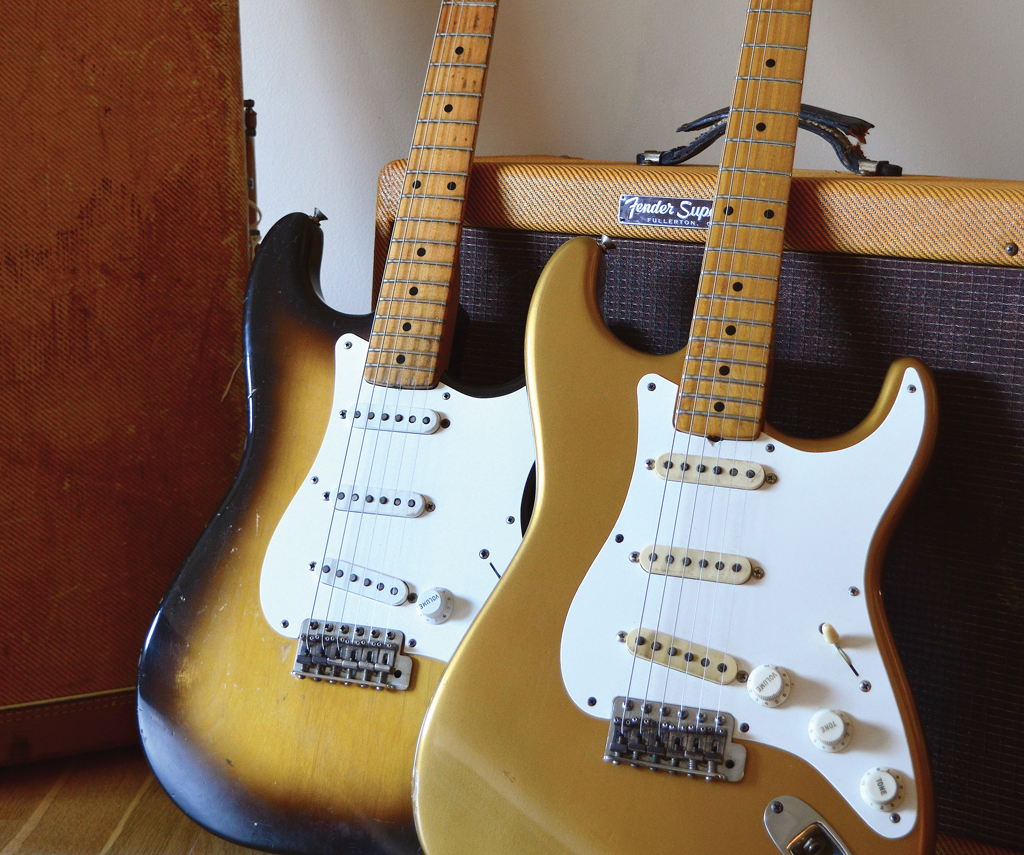
The ’57 Strat aka Goldie (right) alongside a ’56 example provided by Vintage Guitar Boutique (vintageguitarboutique.com)
First impressions
I’ll admit that my heart sank when I encountered Goldie in its non-original case, but then I noticed how light it is. The scales show a mere 7.1lbs, and even by vintage Strat standards that’s pretty featherweight. Acoustically, the tone is loud, unusually chimey, superbly defined and has the effortless ‘freed up’ quality of a thoroughbred.
This unplugged tone is absolutely what I’d associate with a really good vintage Strat. I’ve heard plenty of Custom Shop Fenders, JV reissues and even 80s Tokais that sound very similar; however, few – if any – sound as good as Goldie does through an amp. Although it doesn’t look like much, it certainly feels and sounds like the real deal.
Black light
Before stripping everything down, I tested Goldie under black light.
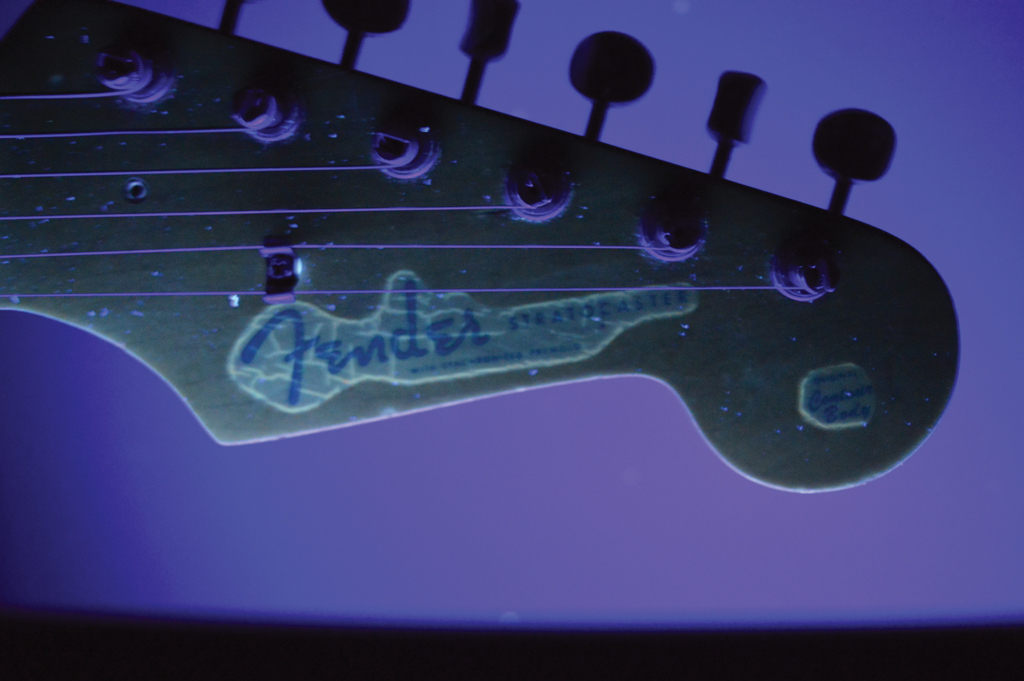
The black light reveals older lacquer beneath the two decals and it looks as if somebody sanded up to the edges to preserve the decal before spraying over them. Unfortunately, small differences between this decal and that of the ’56 suggest Goldie’s is non-original
Although black lighting cannot provide definitive proof that a part is original or even vintage, it can certainly reveal anything that’s fairly recent because it won’t fluoresce. The pickguard, tone knobs, switch tip and pickup covers glowed nicely, but the body didn’t glow at all and the neck glowed only in places.
There’s clearly old finish under the decal and in areas on the back of the neck where the overspray finish transitions into bare wood. This prompted me to test the body and neck finishes in hidden areas using acetone on a cotton bud. Neither finish wiped away with the acetone, so in addition to being non-original, they are not even nitrocellulose.
Date markings
On vintage Strats, there are up to four areas that can give you specific date information. The most obvious starting place is the serial number on the neck plate. Goldie’s 20*** serial number begins with a minus sign, just like Clapton’s Blackie (-20036), and corresponds with 1957 according to various online sources and reference books.
Except for a brief hiatus in early ’59, Fender marked the end of every neck with a pencil date, up until March 1962. Goldie’s neck date reads 3/57 and, considering the neck has been refinished, it’s a nice surprise to find anything there at all.
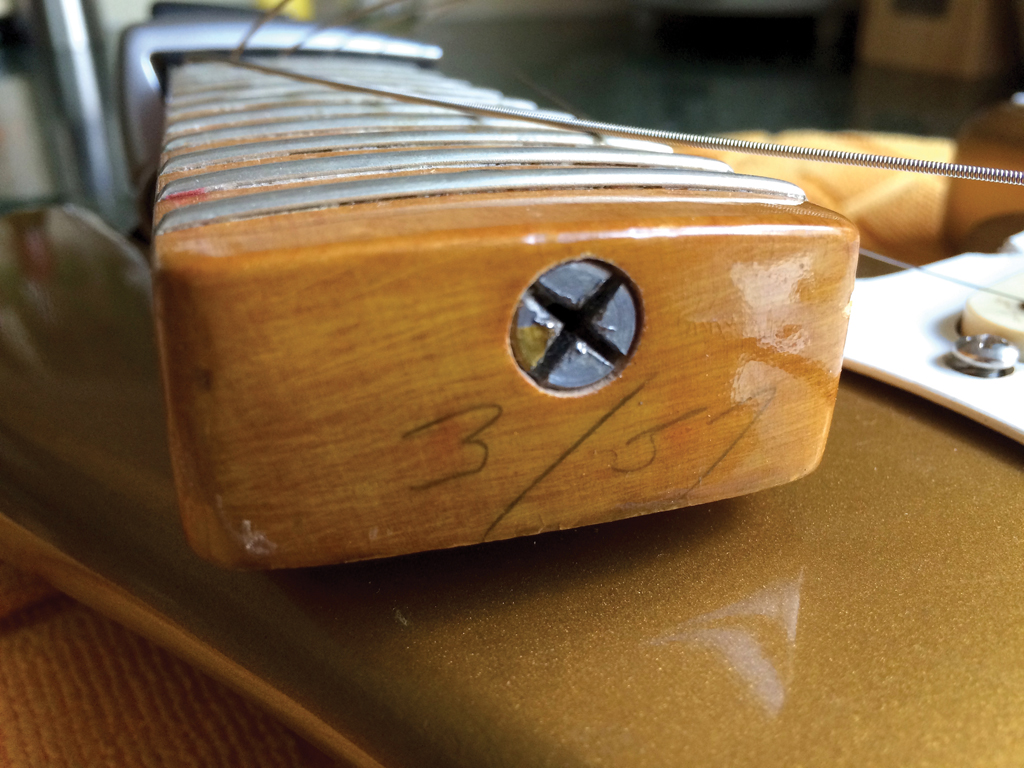
It’s a lot easier to fake a pencil date on the end of the neck than the later stamped dates Fender used. This date looks a bit large, but we did find other examples with similar writing. The jury is out on this
The best was yet to come, as whoever did the body refinish took the trouble to mask off the area under the spring claw, protecting the pencil marks. This time, it reads 10/56 and the yellow background reveals that Goldie’s body originally had a Sunburst finish.
Lastly, I check the control potentiometers. Goldie’s volume pot is a modern replacement, but the other two are old Stackpoles. US potentiometer manufacturers routinely stamped manufacturer and date codes onto their pot casings, and both of Goldie’s tone pots date to the fourth week of 1957.
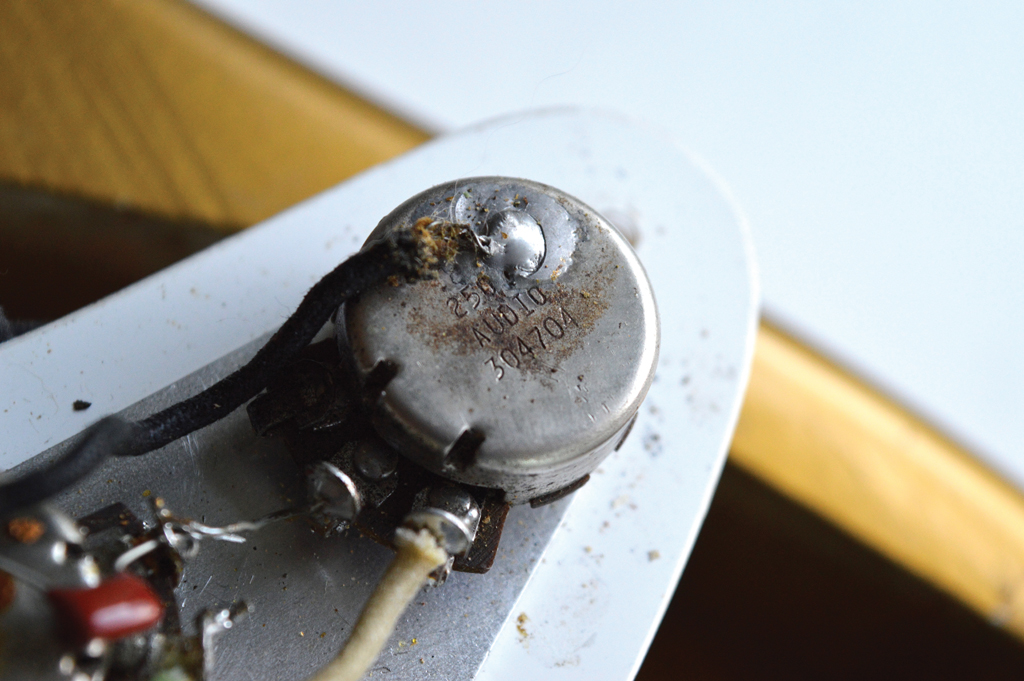
The codes match on the tone pots and confirm that both were made by Stackpole in the fourth week of 1957
So the pots are indisputably old, correspond with the serial number and fall in between the pencil dates. The pencil marks themselves could have been added by anybody at any time, so I searched online for some other 1957 neck dates to compare the handwriting.
It took a while, but I eventually found two necks with dates that looked similar to Goldie’s. Comparing the Sunburst’s body date with Goldie’s, they look so similar that searching out other examples seemed unnecessary.
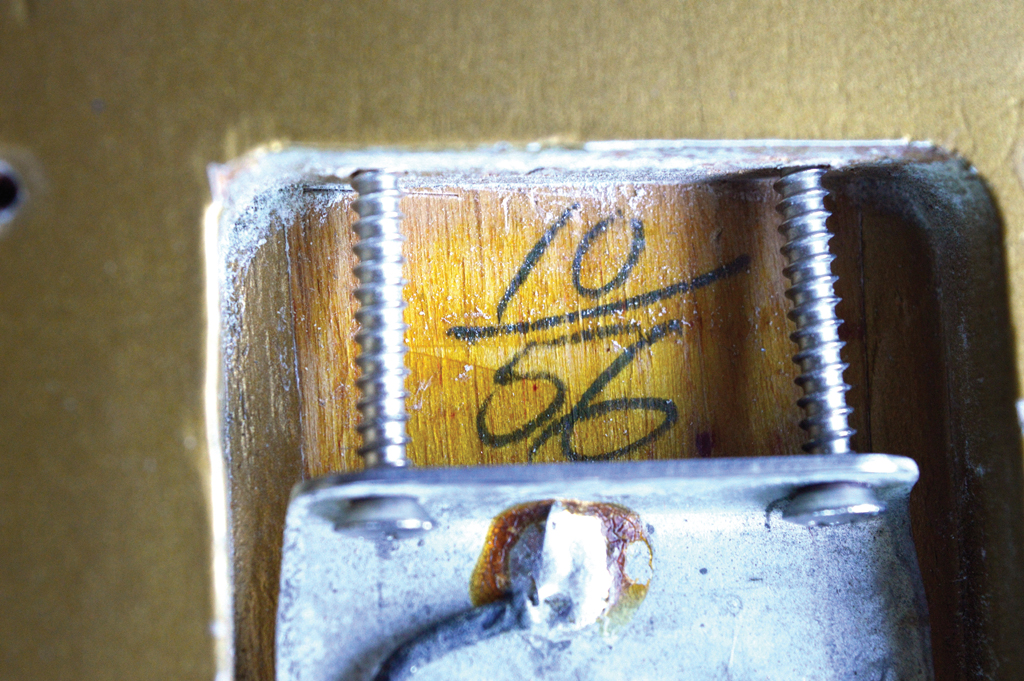
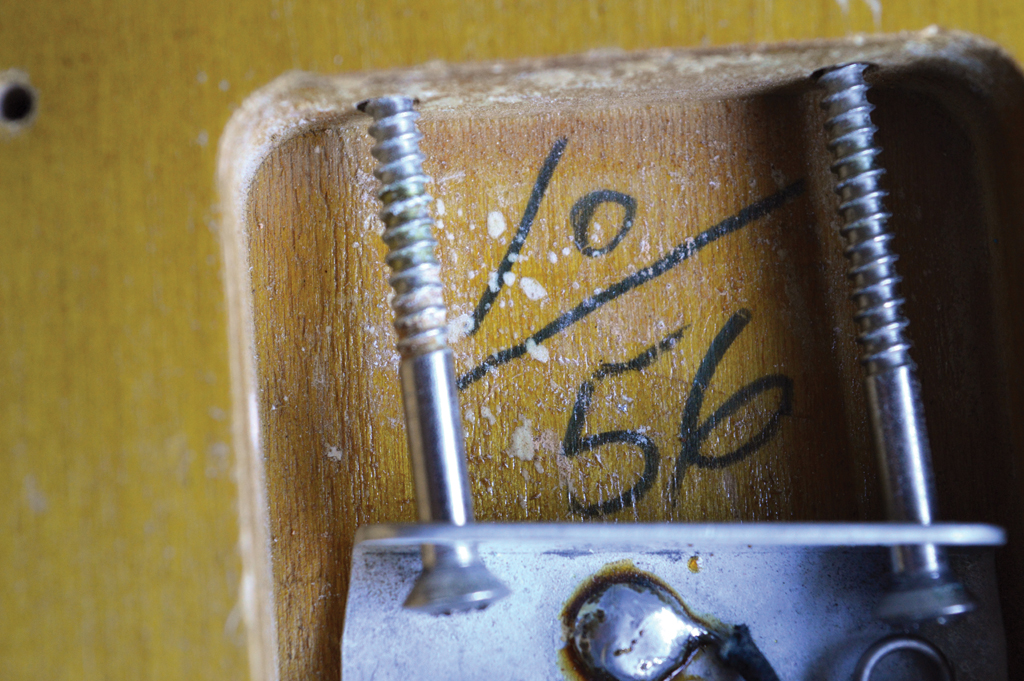
Finding 10/56 body dates on both guitars was a remarkable coincidence, and whoever sprayed the gold finish can be commended for protecting this original feature.
Tuners
Up until 1956, Kluson tuners had no lettering on the rear casing. From 1956 until 1964, you see ‘single line’ tuners with the word ‘deluxe’ stamped along the centre. This changed to a double line ‘Kluson deluxe’ stamp in 1964. You can usually distinguish reproduction tuners because the casing is deeper and you can see a nylon bushing.
Goldie arrived with six vintage single line Klusons, but one has a broken shaft and it clearly came from another set because the casing is less rusty. All six carry ‘Patent No’ stamps under the baseplates, which places them in a 1958-1964 time window.
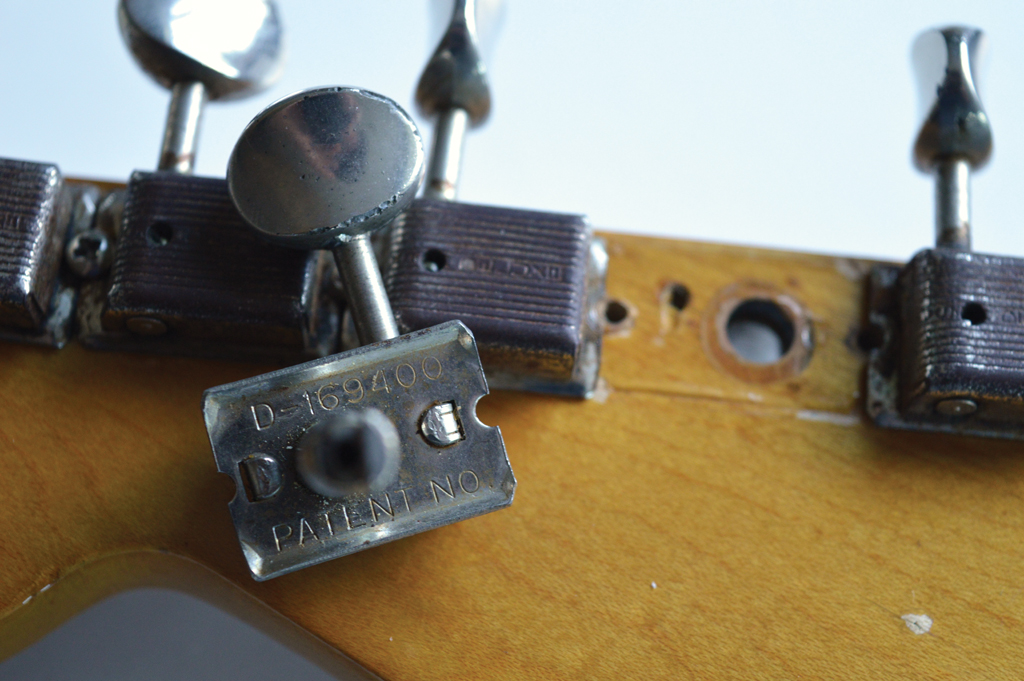
The patent number stamp under this Kluson tuner reveals that it was made between 1958 and 1964. So they’re vintage but non-original.
So, if Goldie did leave the Fullerton factory in 1957, it could not have done so with this set of tuners attached – and the bushes didn’t look right at all.
Bridge
The saddles are heavily corroded and stamped ‘Fender Pat. Pend’ either side of the string slots. About half of the height adjustment screws look to be replacements and the intonation screws have obviously seen a lot of screwdriver action. A couple have even been sawn to allow adjustment with a flathead screwdriver after the crosshead slots had been stripped out. If these saddles are fakes, then they’re the best I’ve seen by a considerable margin.
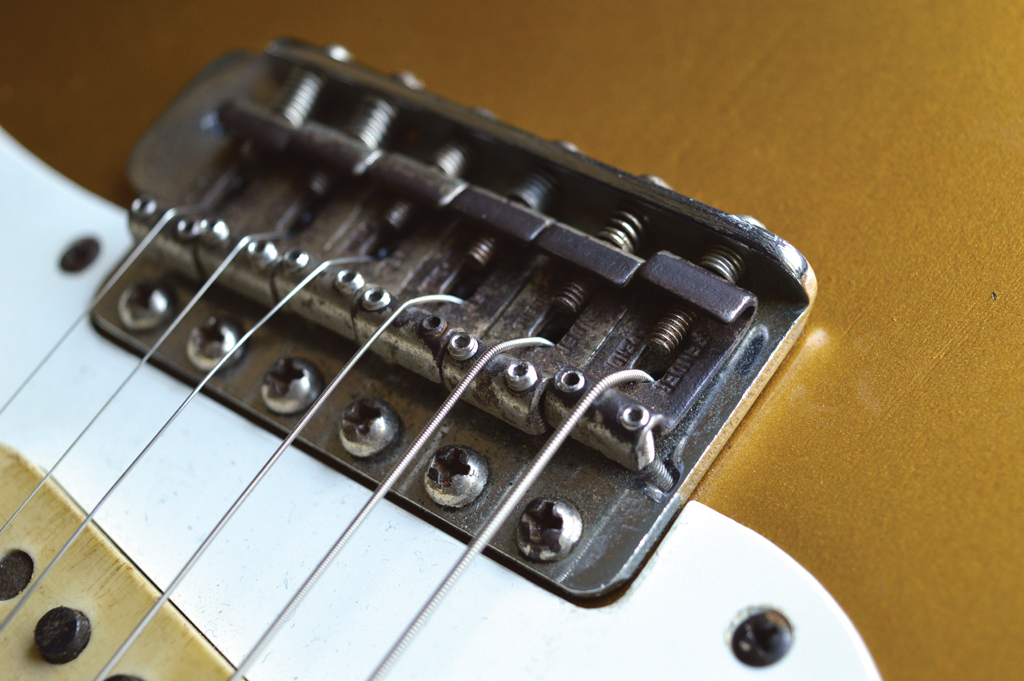
The edges of the bridge plate have rough-casting marks and the saddles have the correct stamps. We’re pretty certain it’s vintage Fender equipment
I always look for rough edges and casting marks on bridge plates because the repros tend to be smooth. You can test whether or not the trem block is steel by checking if a magnet will stick to it, and you can test if a US-spec trem arm with an imperial thread will screw in properly. The ball end recesses should be fairly shallow, too.
Lastly, I looked at the spring claw. It measures two inches across and appears identical in every way to the one in the borrowed ’56. The ground wire solder joint also seems original and intact. So Goldie’s bridge parts appear to pass every vintage test but, again, that doesn’t mean they all date from 1957.
Body
Even with refinished bodies, there are clues you can look for. I struck lucky with the pencil date, and it was by sheer good luck that the body of the borrowed ’56 was made in October too. Areas of exposed wood look a lot more like alder than ash and this is exactly what I’d hope to see on a late ’56 body.
The contours on both ’56 bodies appear exaggerated compared to earlier and later examples but are typical of the period. The tummy tuck is elongated and more extreme and the top chamfer comes down to such a fine edge, you could almost cut yourself on it.
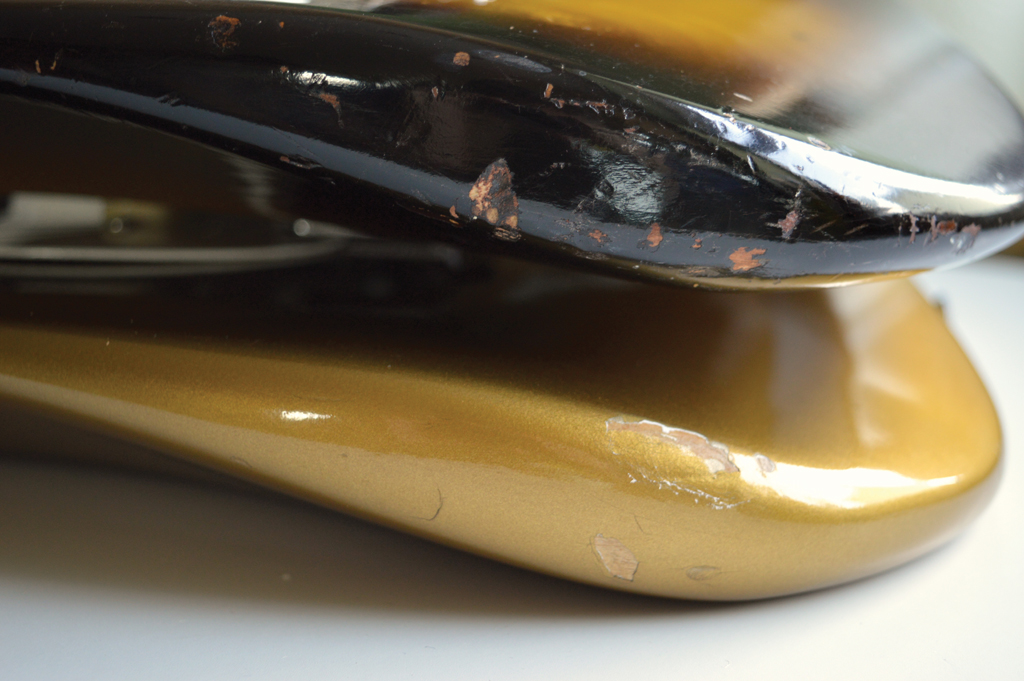

Strat bodies from this era tend to have almost exaggerated contours. Although Goldie’s body has lost some of its thickness, the two bodies look almost entirely identical
The routs of both bodies have identical measurements and the positioning of the strap button on the upper horn is also interesting to note because during this era they were attached a little further round, pointed downwards towards the neck. Fender’s routing jigs would leave holes in the body front and rear. These were filled with dowels, but they are often visible because the finish would sink into them over time. Despite the refinish, the rear dowel holes are easy to spot through the gold finish and they are precisely 13 7/8” apart on both bodies.
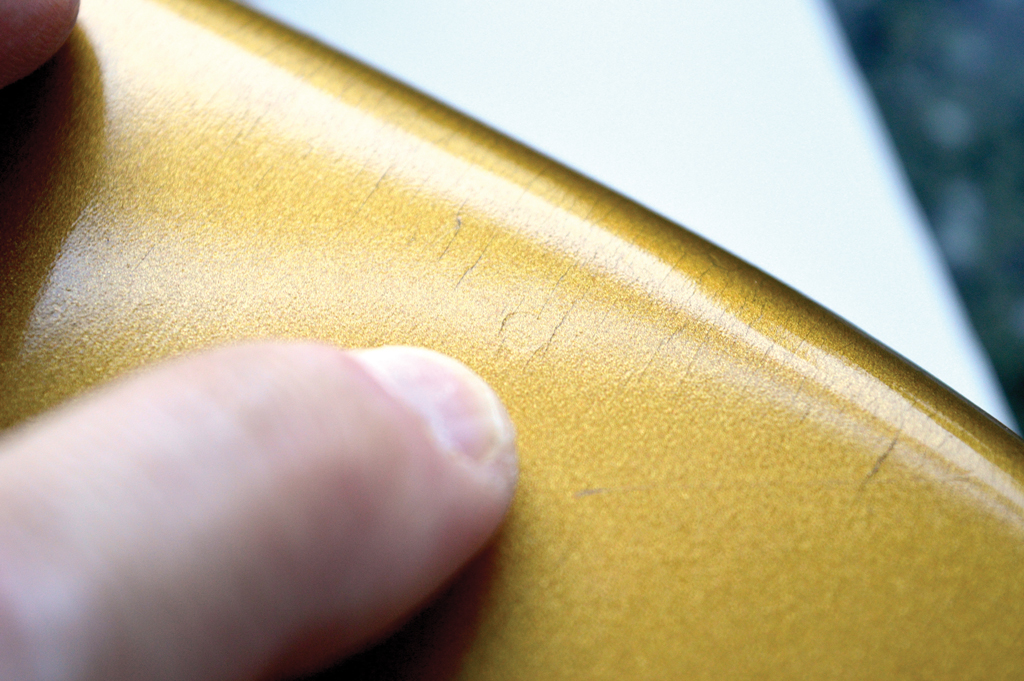
If you know where to look, you can often spot dowels in the body – two on the front and two on the back. These were used to fill holes left by the router jig fixings, and on the back they should be 13 7/8” apart
With the pickguard removed, the routs appear intact but there are some worrying indications that the wood has been filled in the area below the neck and middle pickups. There are all the correct router marks, the cable channel was routed freehand with the typical fuzzy edges and there are a couple of dimples in the finish that correspond to the positions Fender used for spacer nails.
I feel some trepidation about what’s under the finish, but based on the contouring, the exact locations of the jig holes and the shape of the routs, I conclude that the body is genuine. Unless it’s an elaborate double bluff, but why would anybody go to so much trouble to recreate a perfect late ’56 shape, then fake ill-advised 1970s-style modifications, over-sanding and a flawless pencil date before spraying the body with poly finish in a shade of gold that isn’t even vintage-correct?
Neck
The neck causes the greatest concern. The soft V feels just right, but there is a lack of front-to-back depth. The top of the walnut plug is exposed in the area behind Goldie’s nut, but on the borrowed ’56 there’s about 1/16” to spare.
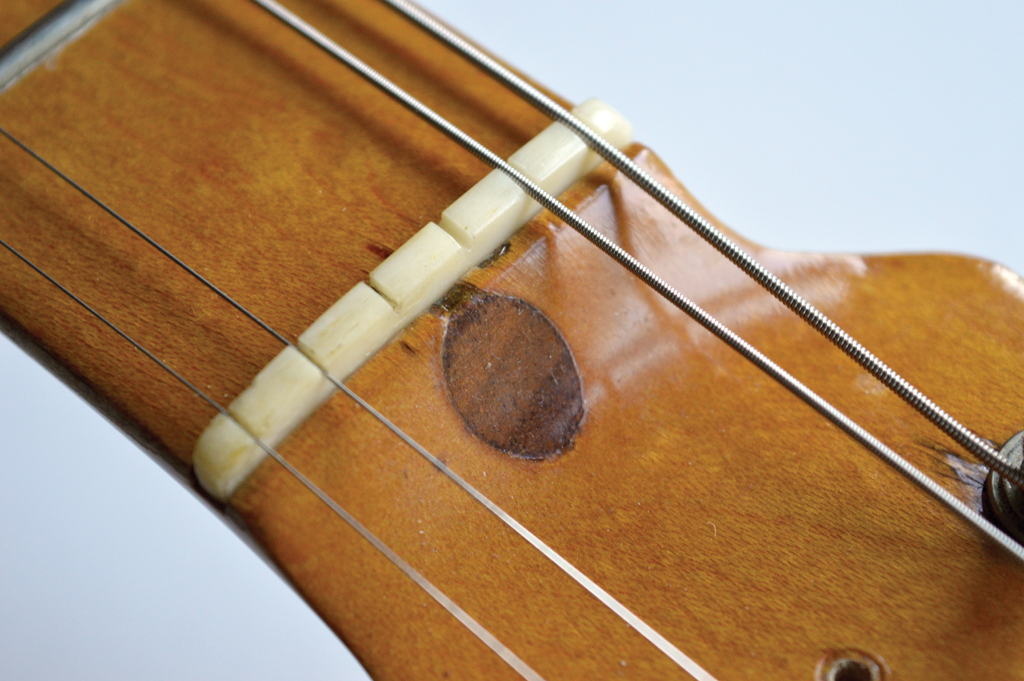
Over-sanding the fretboard has exposed the top of the walnut truss-rod plug. These were located very close to the surface and the walnut can often be seen in the nut slot
My guess is that depth was lost when someone sanded the fingerboard prior to the neck refinish – presumably in an attempt to eradicate the finger marks that are commonly found on 50s maple necks and simulated on modern relics.
The close proximity of the side dots to the fingerboard edges supports the over-sanding theory, and whoever did the work would have needed to sand quite deep to get beyond the finger marks. The upshot is that Goldie’s neck has lost about a millimetre in depth all the way along, and depth measurements taken from the ’56 neck seem to confirm this.
There’s little or no finish on the back of the neck, but it looks and feels vintage, and it’s fortunate that it was left alone when the neck was resprayed. The new finish was applied poorly, especially over the fingerboard, appearing lumpy and uneven. At least the medium jumbo frets make Goldie really nice to play.
There’s more bad news at the headstock, which is 1/16” thinner than usual near the low E tuner and tapers by another 1/32” at the top E tuner.
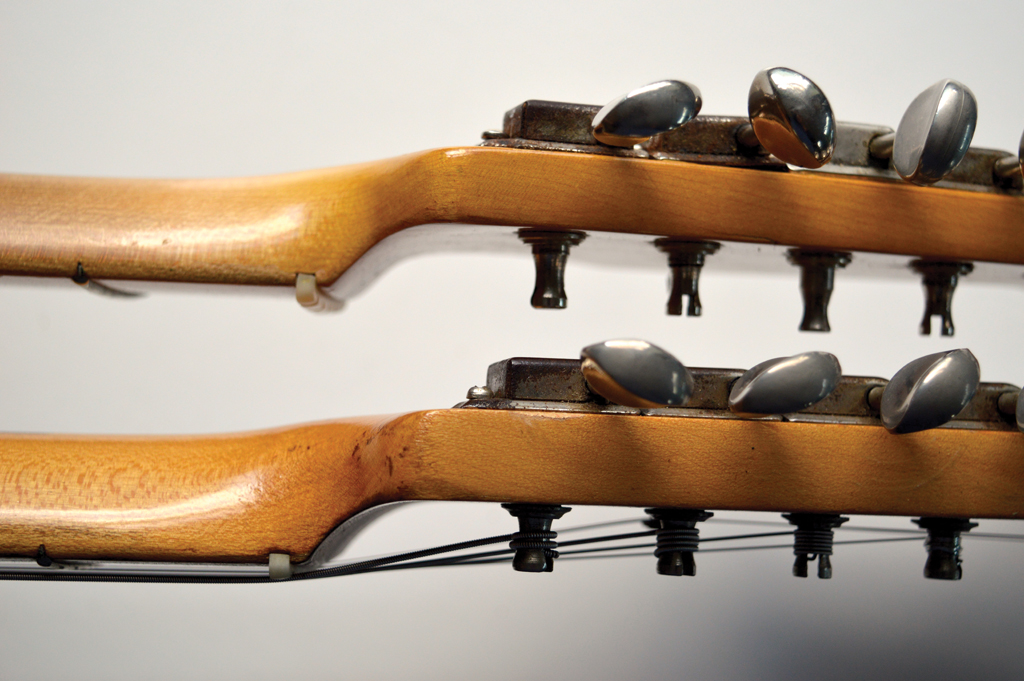
More over-sanding on the back of the headstock has reduced its thickness. You can see how the tuner posts extend further from their bushings – Goldie’s headstock is the one on top
Measurements show that thickness was lost from the rear of the headstock rather than the front; it seems that wooden plugs have been inserted in the post holes at some point.
Presumably depth was lost when the plugs were sanded flush, but since there’s no evidence of tuners other than Klusons ever having been fitted to Goldie, why this was done remains a mystery.
The router jig holes are present, adjacent to the D string tuner and in the area between the body fixing screws. The straight underside of the headstock profile and the tiny teardrop walnut plug are also consistent with a ’56-’57 timeframe. Earlier and later vintage Strats always seem to have an elongated plug shape – as do the reissues. Even the unusual decal placement is remarkably similar on both Strats. It looks as if somebody carefully sanded up to the edge of Goldie’s original decal before blowing new finish over the top.
Lastly, I tried swapping the truss-rod adjuster with one from a ’63 Strat. Were the neck Far Eastern in origin, an adjuster with an imperial thread would not fit. My conclusion is that the neck has been much molested but it’s probably original.
Electrics
Unlike many modern reproduction units, Goldie’s pickups sound as vintage as they look. There is some evidence of a repair to the neck pickup and the cover doesn’t push down completely over the middle pickup. This indicates the flats may have flared out during a rewind, and this is confirmed when the covers are removed. The wire is darker and redder on the neck and bridge pickups and both sound better than the middle unit.
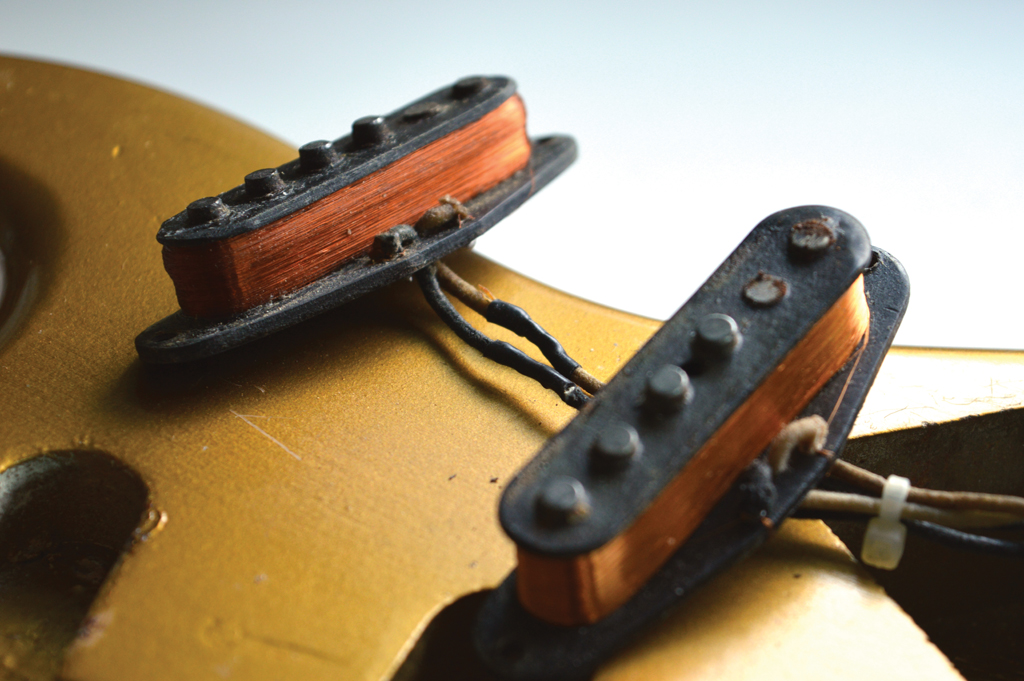
Both pickups look very old, but we think the middle pickup has been rewound. The magnet wire has a lighter, more coppery appearance and although it sounds good, the neck and bridge sound better
The neck pickup lead-out wires have been extended, and it seems unlikely that anybody would choose to do that, were this a recently-made replica. All three read close to 5.8k ohms with a multimeter and the magnetic polarity is north. It’s another good sign; Fender reversed the polarity of the slugs to south in 1960. Besides the replaced volume pot mentioned earlier, there’s a modern five-way switch and tone capacitor. The cloth wiring is a mix of old and new.
Plastics
The typeface on the volume knob and the absence of spokes indicates that it is Far Eastern and, since it is clearly quite old, probably Japanese. The tone knobs both have three spokes, the correct typeface and a yellowed patina that is consistent with the way ABS plastic often ages. The pickup covers and switch tip glow under black light, and have the correct mould marks for Fender parts of this era.
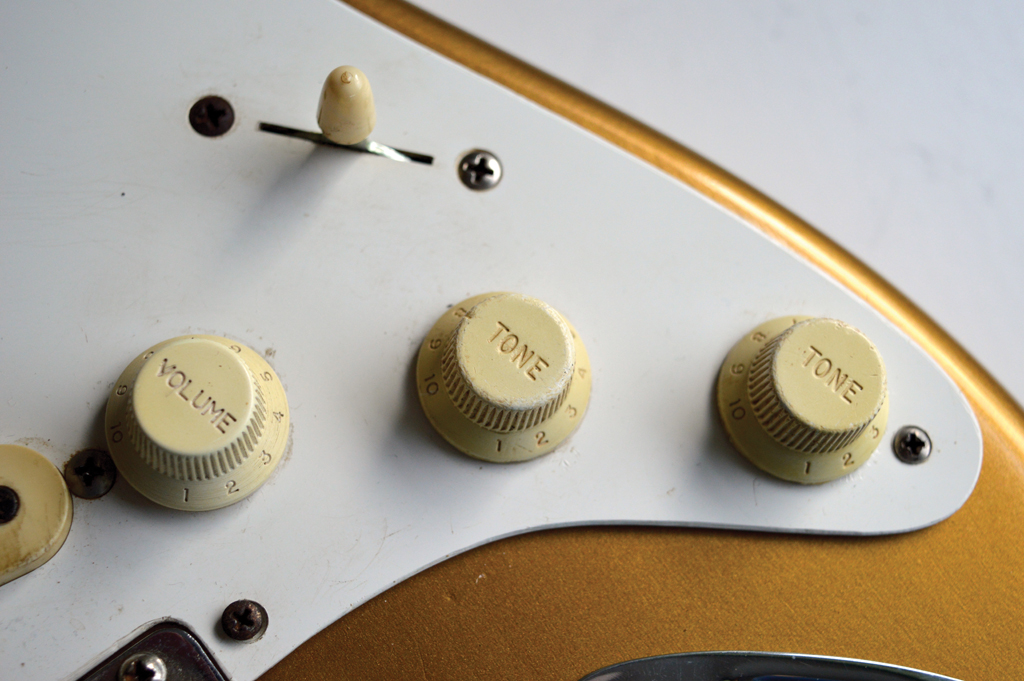
Goldie appears to be carrying two vintage tone knobs, but the volume knob is Far Eastern. The pickup covers and switch tip glow under black light and the moulding marks look right for a pre-CBS Strat
The rear spring cover’s edges are very rounded and it doesn’t look quite right, plus the screw holes are spaced differently to those on the ’56. In contrast, the pickguard appears legitimate, with slight warping on the bass side. Markings on the sides of the pickguard suggest the guards were manufactured in the same way, with the same 1/16” thickness and without the straight sides and square corners of modern reproductions.
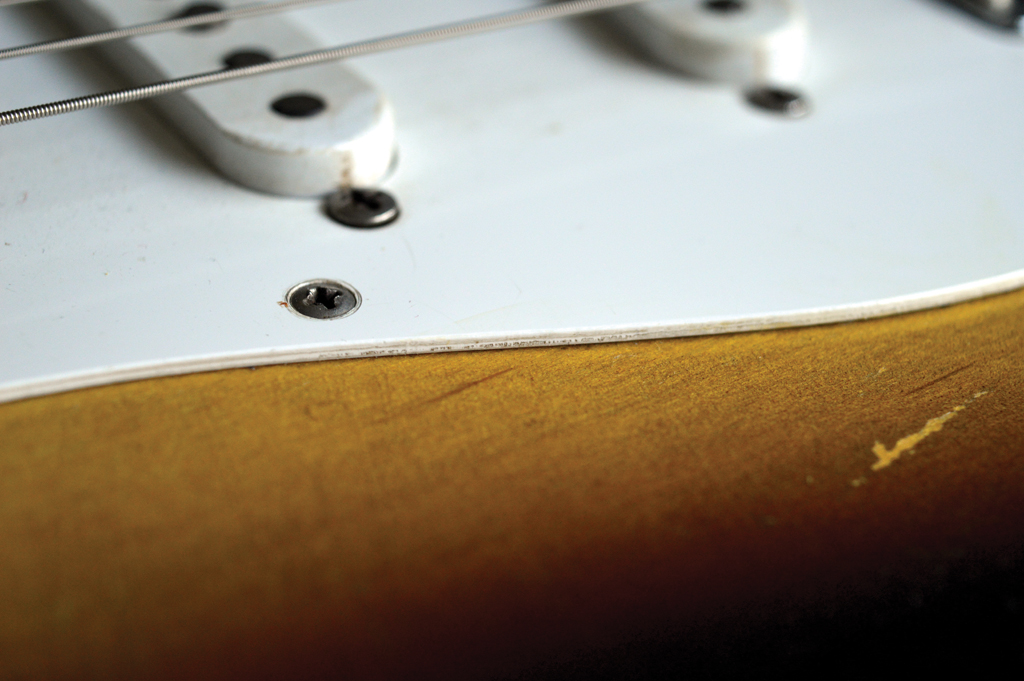
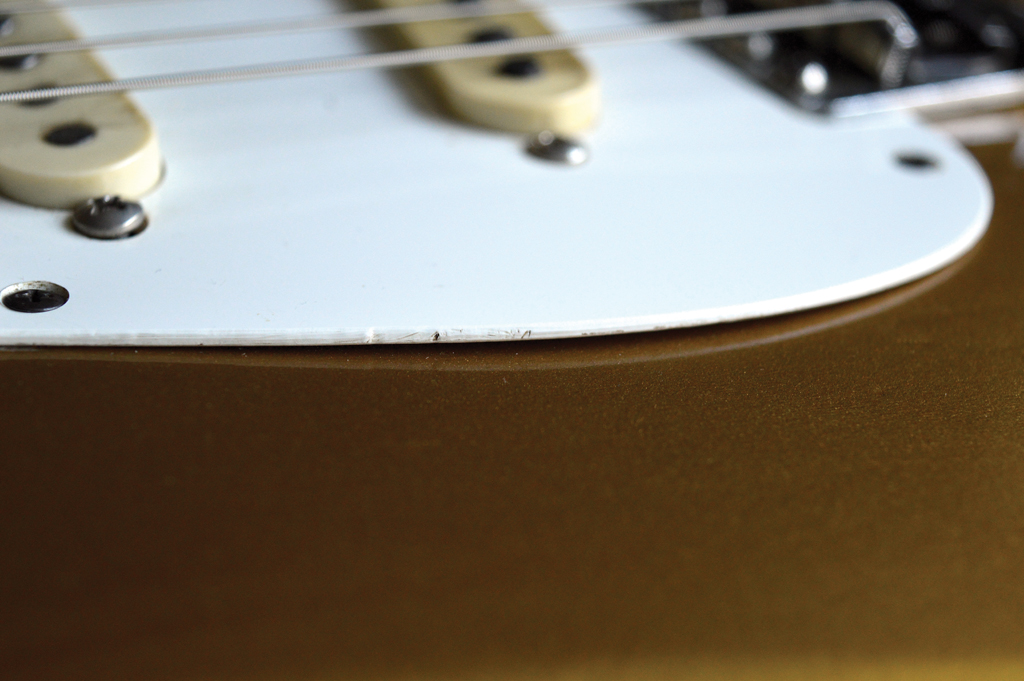
The pickguards on both guitars appear identical under both natural and black light and the markings around the edges are very similar
Verdict
It’s hard to keep emotions in check during a project like this because one would always hope for the guitar to be genuine. Sometimes you have to go with your gut feeling. With that caveat, my conclusion is that Goldie has many pre-CBS parts, but it’s impossible to say if they all left the Fender factory on the same day. Besides some suspect ‘woodwork’ that may be revealed once the finish is removed and the ill-advised neck reshaping, it appears to be the real deal.
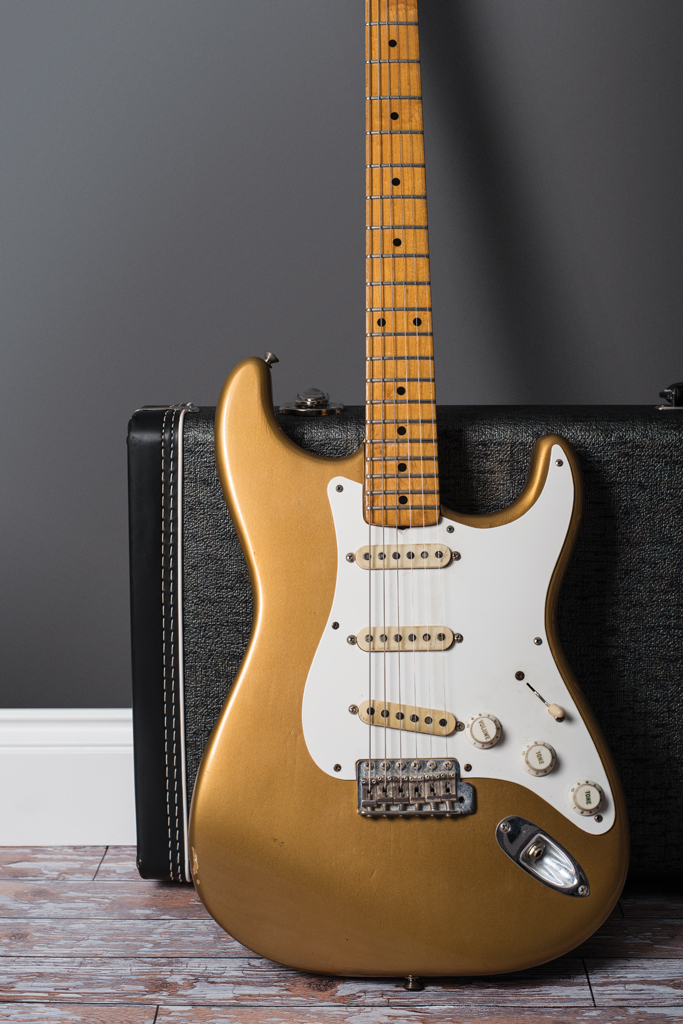
By any standards, this is an outstanding-sounding Strat and despite the neck vandalism, it plays like a dream. It’s sad that Goldie is worth more as a collection of parts than it is as a complete guitar, but the plan is to restore it regardless. I’m looking forward to performing the work and covering the process in forthcoming issues of G&B.
